
WHETHER it be a daily driver or purely for recreation, when most of us dream about a new 4x4 we have to compromise.
This was first published in 4x4 Australia’s December 2011 issue.
But when Holden Rally Team supremo Kees Weel considered his new 4x4, he faced no such angst: the new HRT Colorado would have only one objective – to win the Australasian Safari.
 But such a vehicle already existed. Last year’s winner – driven by Craig Lowndes with Kees in the left-hand seat – was sitting in the foyer of Paul Weel Racing (PWR) needing little more than some fibreglass work and an oil change before heading to Western Australia for the 2011 Safari – so why clone a new one.
But such a vehicle already existed. Last year’s winner – driven by Craig Lowndes with Kees in the left-hand seat – was sitting in the foyer of Paul Weel Racing (PWR) needing little more than some fibreglass work and an oil change before heading to Western Australia for the 2011 Safari – so why clone a new one.
“The ‘old’ one was first driven in the Safari by Peter Brock back in 2004,” explains Kees. “It won the event in 2007 with John Hederics and John Williams before Craig and I won last year. Our plan is for me to navigate for (son) Paul with Craig and John Panozzo in the proven unit.”
Both vehicles are based on Holden’s Colorado Spacecab Ute and while they retain the original chassis and cab – including doorskins – almost everything else is custom engineered. More like built from scratch than modified, even if many of the parts are standard.

Kees waved away the dynamometer figures declaring that HRT are not into bench racing and that – like Rolls-Royce – the power is adequate. Certainly it should be reliable as both engines – at around 330kW and 500Nm of torque – are no more stressed than thousands of HSV models released over the past decade.
Keeping the power and torque in the right zone is controlled by a Hollinger six-speed sequential gearbox, with the same ratios as the V8 Supercar units. To ensure this mass doesn’t become wedded to the ironstone boulders of Western Australia’s goldfields, Alcon 315mm vented discs and four-piston calipers are employed at each corner; a big increase in braking capability over past years.
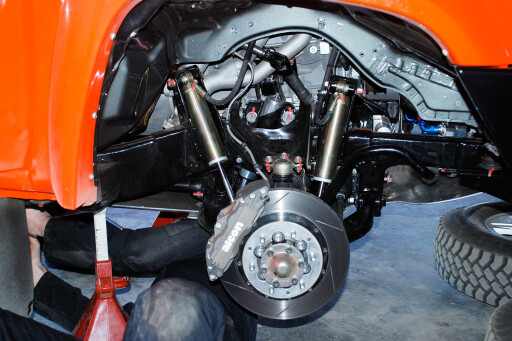 Whilst it’s inevitable, looks spectacular, and may save on tyre wear, getting airborne doesn’t really aid forward progress and it’s the dark art of keeping the rubber attached to terra firma more than any other factor that separates the winners from the also-rans – never mind the many DNFs due to suspension damage.
Whilst it’s inevitable, looks spectacular, and may save on tyre wear, getting airborne doesn’t really aid forward progress and it’s the dark art of keeping the rubber attached to terra firma more than any other factor that separates the winners from the also-rans – never mind the many DNFs due to suspension damage.
For many years Murray Coote has been the go-to man for suspension and Murray is responsible for each of the eight handbuilt shock absorbers it takes to keep the Colorado moving swiftly across the landscape no matter how rough the terrain.
All of this expense and expertise would be pointless without the appropriate rubber which in this instance is the same BF Goodrich Rallye Raids worn by most Dakar and Safari winners over the past decade. The HRT vehicles run standard 16-inch alloy rims and 235/85 profiles, giving an overall rolling diameter of 808 mm.
If you’d like a set just ask for the G1 Rock spec and get your wallet out. Five grand will see you out the shop with a spare on the back – but remember they’re for competition use only and each set might just see the day out as long as you don’t get a puncture.
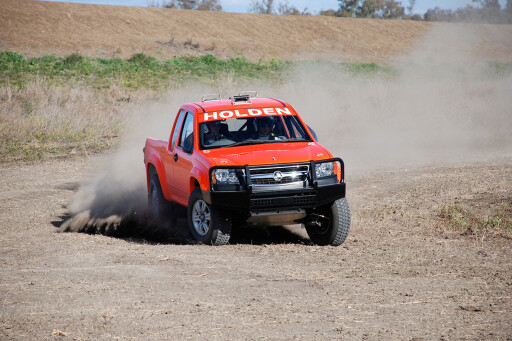 HRT’s Peter ‘Pops’ Glennie is the man in charge and maintains pressures should be set at 28psi, which will increase to 40-42psi once the driver gets angry. This significantly decreases – but will never eradicate – the incidence of punctures which can quite easily cost a race win.
HRT’s Peter ‘Pops’ Glennie is the man in charge and maintains pressures should be set at 28psi, which will increase to 40-42psi once the driver gets angry. This significantly decreases – but will never eradicate – the incidence of punctures which can quite easily cost a race win.
Three spares are carried in quick-release ratchet straps directly behind the 350-litre fuel tank in the bed of what would normally be a ute tray –shortened by 150mm to provide a better exit angle and, with the huge inner wheel arches, fuel tank, workshop jack, base plate, shovel and tools there’s only just room for a couple of oil coolers and fans.
The devil is in the detail and everyone has heard a story about a million-dollar race effort being brought undone by the failure of a 20-cent part. No one has learnt the secret of how to eliminate this risk entirely but the Holden Rally Team has the combined knowledge to reduce it to a minimum.
The trio of Kees Weel, Peter Glennie and John Hederics have participated in more than 40 Safaris and hundreds of other off-road events over the past quarter-century. They have first-hand experience at – just about – everything that can go wrong, which allows them to focus on the unknowns.
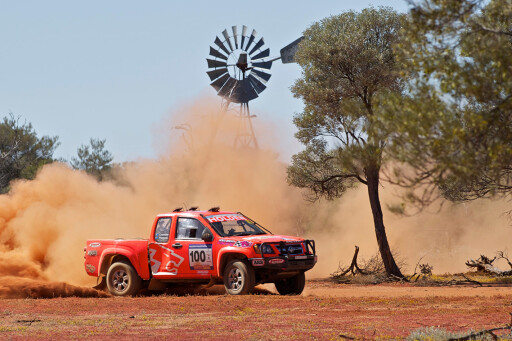 Which is why, a full six weeks out from the Safari, both vehicles were fully fettled and ready for back-to-back testing on Peter Glennie’s private test tracks north-west of Moree.
Which is why, a full six weeks out from the Safari, both vehicles were fully fettled and ready for back-to-back testing on Peter Glennie’s private test tracks north-west of Moree.
Other than rolling tests to ensure that all systems were working as they should, the prime purpose of the two-day test session was to evaluate suspension settings and tune the airflow for optimal cooling.
Minor issues involved testing the gauge on the mesh of the radiator protectors and the possible addition of a couple of vanes to deflect airflow to the engine bay better. It was then time for Craig to take everyone for a ‘spin’. Five minutes was fun but I don’t know about five hours – even though the ride was remarkably smooth.
Craig has adapted easily from the 450kW he enjoys on the blacktop to 330kW on the black soil; and judging by the results last year where he slotted a Safari win between his Supercar victories at Phillip Island and Bathurst in the space of three weeks it was all looking good for a repeat.
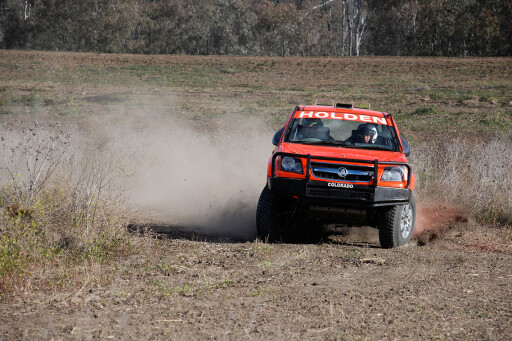 The first two days of the 2011 Safari proved both PWR-built cars were winners with Paul and Kees fastest in the prologue and the Lowndes/Panozzo car in front at the end of the first day.
The first two days of the 2011 Safari proved both PWR-built cars were winners with Paul and Kees fastest in the prologue and the Lowndes/Panozzo car in front at the end of the first day.
But the crews aren’t racing one another, the Safari is really the ultimate speed trial to test who can best avoid all the obstacles mother nature has strewn across the landscape.
And while all forms of motorsport have their dangers, there are no run-off areas or tyre barriers in the bush where every hardened branch appears to be engineered to puncture a tyre or radiator, every rock positioned to do maximum damage to the suspension and every bulldust hole ready to swallow a wheel assembly.
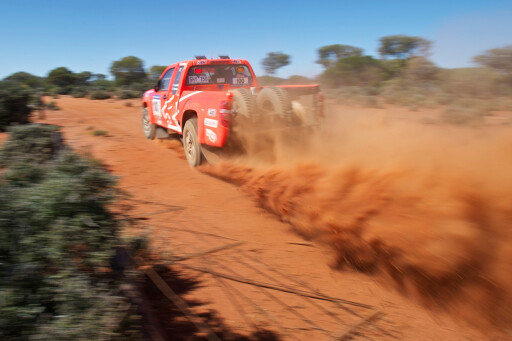 It was a dead mulga tree, or maybe two, that stopped Paul’s car in its tracks with enough damage that it was decided to keep all spares available for Craig’s car. Craig and John built on their lead every section and by the end of day four enjoyed an almost insurmountable lead.
It was a dead mulga tree, or maybe two, that stopped Paul’s car in its tracks with enough damage that it was decided to keep all spares available for Craig’s car. Craig and John built on their lead every section and by the end of day four enjoyed an almost insurmountable lead.
However the mulga remained malicious, Craig clipped a stump and tipped the Colorado on its side. The team repaired the damage overnight and the Colorado stormed back through the field to finish fourth. But, like Arnie, they’ll be back – next year.
ONE-ON-ONE WITH CRAIG LOWNDES
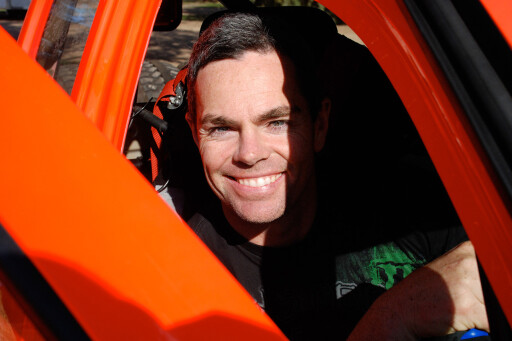 The 2010 Safari was your first off-road event, and that in a car you’d never driven before. How did you prepare?
The 2010 Safari was your first off-road event, and that in a car you’d never driven before. How did you prepare?
Well I grew up on a property and I’ve always had dirt bikes and paddock bombs to play with but I’ve never really been into 4X4s, so it was a steep learning curve but former Safari winner John Hederics knows the car back to front and helped me to get a handle on it.
It appears you became very comfortable fairly quickly.
Last year was the first time I’ve really driven a 4X4. As the Safari went on I became more comfortable and learnt how to position and slide the car and get it to the end of the day – and not to get a flat.
It all went belly up this year. How did it all go wrong?
We’d built a comfortable lead and were first car on the track but we had to press on because even something simple like a flat tyre can cost you the lead. I slid into a dead tree, which tore out the rear suspension and that was our race.
What’s it like having someone next to you calling the shots?
Having someone beside me was another thing I had to get my head around. If I have a crash it’s my own fault and I’d be the only one likely to get hurt. Having someone else to worry about was quite different, though the cars are incredibly safe.
How much different are the V8 Supercars to the Safari?
V8 Supercars runs as a business. It’s a great job but there’s no novelty. It’s really great to do the Safari, not knowing how hard or fast it would be, not knowing the competition.
Peter Brock had a great affinity with the Safari. Did that influence you?
Peter loved the Safari and tried to win it a number of times, so our win in 2010 a great sense of achievement. It was as tough an event as I’ve ever done; like getting up and doing the Bathurst 1000 every day. But it’s a lot of fun and the camaraderie around the bivouac is terrific. Given the opportunity I’ll be back. The Safari is just like racing was 20 years ago.

COMMENTS